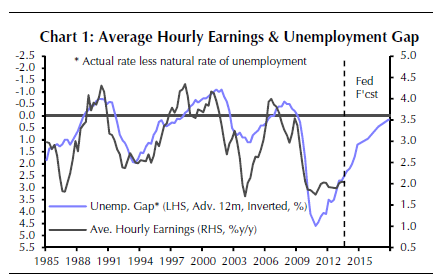Why you may be getting a raise soon
Consumers have it tough right now. The holiday shopping season was a disappointment as stagnant wage growth forced households to dip deeply into savings. In fact, real disposable personal income is dropping at a rate not seen since the mid-1970s -- falling below the lows hit during the recent financial crisis and recession.
Not only are wages stagnant for most, but many simply aren't working. Some 92 million Americans are now outside the confines of the job market, more than 37 percent of the population, up from less than 33 percent during the dot-com bubble.
All of this comes despite the fact that corporate profits are at record highs, that the economy has been expanding since 2010 and that the nation's GDP has never been larger. The simple truth is that the spoils of the recovery thus far have overwhelmingly gone to business owners and shareholders, while the share of profits going to laborers has plummeted.
But we could be on the cusp of a turnaround.
With the unemployment rate down to 6.7 percent from a peak of nearly 11 percent, and with so many folks dropping out of the workforce, a labor shortage is beginning to emerge. This comes as businesses begin to max out the level of production that can be maintained using their existing workforce.
As a result, evidence is growing that workers are about
to enjoy a rebound in wages of a kind not seen in nearly 10 years.
In a note to clients, the team at Capital Economics highlights eight reasons to believe take home pay is about to drift higher:
One, the relationship between the current unemployment rate and the "natural," or full, employment rate suggests annual growth in average hourly earnings could increase from 2 percent to 3 percent by the end of the year. In the last economic cycle, this measure maxed out at nearly 4 percent.
Two, the percent of small businesses surveyed by the National Federation of Independent Business (NFIB) saying jobs are hard to fill has risen to levels not seen since 2007 -- which also suggests an increase in the annual growth rate of average hourly earnings to 3 percent.
Three, the relationship between Conference Board's measure of jobs being plentiful vs. hard to find suggests annual growth in average hourly earnings increases to near 2.5 percent this year.
Four, based on the turnaround in the job opening rate in the government's JOLTS data, annual growth in average hourly earnings should increase to just under 3 percent.
Five, the job quits rate in the JOLTS data (known as the "take this job and shove it" index) points to a 2.75 percent annual growth rate in average hourly earnings by the end of the year.
Six, NFIB firms planning a rise in compensation points to a 3 percent annual growth rate in average hourly earnings.
Seven, respondents to the Richmond Federal Reserve Bank's business survey pointed to an expectation of an increase in future wages associated with a 2.5 percent annual rise in average hourly earnings this year.
And finally, a similar survey by the Dallas Fed suggests the annual growth rate in average hourly earnings to increase to near 3.5 percent this year.
While this would be fantastic news to beleaguered middle-class Americans, there's a catch: The evidence also suggests that with the
labor market tightening, and wages poised to increase, inflation could be
pushed higher as well. Especially shelter costs as rents increase.
Anthony Mirhaydari is founder of the
Edge,
an investment advisory newsletter, as well as Mirhaydari Capital Management, a registered investment
advisory firm.

